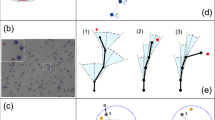Abstract
In order for immune cells to carry out many of their functions, including clearance of infectious agents from tissue, they must first encounter their targets in the tissue. This encounter process is often the rate-limiting step in the overall function. Most immune cells exhibit chemotactic ability, and previous continuum models for encounter rates and dynamics have shown that chemotaxis can be a great advantage to cells by greatly increasing encounter rates relative to those for randomly moving cells. This paper describes computer simulations of discrete cell-target encounter events in two dimensions, for the two cases considered by the continuum models: where only a single cell and a single target are present, and where many cells and targets are present. The results of these simulations verify our previous model predictions that a small amount of chemotactic bias dramatically decreases the encounter time, while further increases in the amount of bias have a much smaller effect. Chemotactic ability is shown to be an important determinant of the kinetics of target clearance, and its effects depend on the initial cell-target ratio and the initial distributions of cells and targets.
To the best of our knowledge, this work provides the first computer simulations of particle-target encounter in which there is biased motion of particles toward their targets, and is therefore of general interest beyond specific application to immune cell function.
Similar content being viewed by others
Literature
Allan, R. B. and P. C. Wilkinson. 1978. A visual analysis of chemotactic and chemokinetic locomotion of human neutrophil leukocytes.Exp. Cell Res. 111, 191–203.
Alt, W. 1980. Biased random walk models for chemotaxis and related diffusion approximations.J. math. Bol. 9, 147–177.
Dahlgren, C., J. Hed, K.-E. Magnusson and T. Sundqvist. 1979. Characteristics of individual polymorphonuclear leukocyte motility obtained with a new opto-electronic method.Scan. J. Immunology 9, 537–545.
Dunn, G. A. (1982). Characterizing a kinesis response: time-averaged measures of cell speed and directional persistence.Agents Actions Suppl. 12, 14–33.
Farrell, B. E., R. P. Daniele and D. A. Lauffenburger. 1990. Quantitative relationships between single-cell and cell-population model parameters for chemosensory migration responses of alveolar macrophages to C5a.Cell Motil. Cytoskel. In press.
Fisher, E. S. 1988. The effect of chemotaxis on immune cell-target rates and target clearance rates. Ph.D. thesis, University of Pennsylvania.
Fisher, E. S. and D. A. Lauffenburger. 1987. Mathematical analysis of cell-target encounter rates in two dimensions: the effect of chemotaxis.Biophys. J. 51, 705–716.
Fisher, E. S., D. A. Lauffenburger and R. P. Daniele. 1988. The effect of chemotaxis on bacterial clearance from the lung surface.Am. Rev. Resp. Dis. 137, 1129–1134.
Lauffenburger, D. A. 1985. Mathematical analysis of the macrophage response to bacterial challenge in the lung. In:Mononuclear Phagocytes: Characteristics, Physiology, and Function. R. van Furth (ed.), pp. 351–358. Dordrecht: Martinus Nijhoff.
Lehnert, B. E. and P. E. Morrow. 1985. The initial lag in phagocytic rate by macrophages in monolayer is related to particle encouters and binding.Immunological Invest. 14, 515–521.
Lehnert, B. E. and C. Tech. 1985. Quantitative evaluation of opsonin-independent phagocytosis by alveolar macrophages in monolayer using polystyrene microspheres.J. Immunological Meth. 78, 337–44.
Redner, S. and K. Kang. 1984. Kinetics of the “scavenger” reaction.J. Phys. A. 17, L451-L455.
Rivero, M. A., R. T. Tranquillo, H. M. Buettner and D. A. Lauffenburger. 1989. Transport models for chemotactic cell populations based on individual cell behaviour.Chem. Engng Sci. 44, 2881–2897.
Rothstein, T. L., M. Mage, G. Jones and L. McHugh. 1978. Cytotoxic T lymphocyte sequential killing of immobilized allogeneic tumor target cells measured by time-lapse microcinematography.J. Immunology 121, 1652–1655.
Tranquillo, R. T., E. S. Fisher, B. E. Farrell and D. A. Lauffenburger. 1988. A stochastic model for chemosensory cell movement: application to neutrophil and macrophage persistence and orientation.Math. Biosci. 90, 287–303.
Walsh, C. A. and J. J. Kozak. 1981. Exact algorithm ford-dimensional walks on finite and infinite lattices with traps.Phys. Rev. Lett. 47, 1500–1502.
Walsh, C. A. and J. J. Kozak. 1982. Exact algorithm for d-dimensional walks on finite and infinite lattices with traps. II. General formulation and application to diffusion-controlled reactions.Phys. Rev. B26, 4166–4189.
Wilkinson, P. C. 1982.Chemotaxis and Inflammation (2nd edn.) Churchill-Livingston: Edinburgh.
Author information
Authors and Affiliations
Rights and permissions
About this article
Cite this article
Charnick, S.B., Fisher, E.S. & Lauffenburger, D.A. Computer simulations of cell-target encounter including biased cell motion toward targets: Single and multiple cell-target simulations in two dimensions. Bltn Mathcal Biology 53, 591–621 (1991). https://doi.org/10.1007/BF02458631
Received:
Revised:
Issue Date:
DOI: https://doi.org/10.1007/BF02458631




